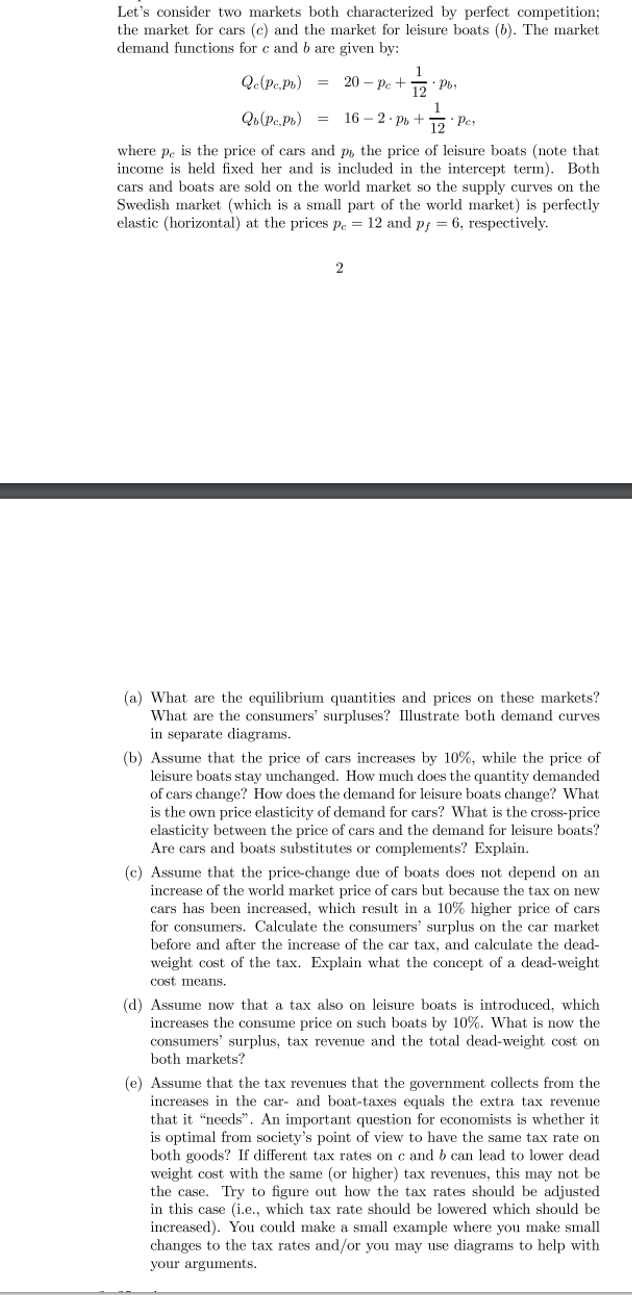
Let's consider two markets both characterized by perfect competition; the market for cars (C) and the market for leisure boats (b). The market demand functions for c and b are given by: 1 Qc Pcp) 20 - Pe+ Pb, 12 1 Qs(pe.po) = 16 - 2. Po + 12 Pcs where pe is the price of cars and p, the price of leisure boats (note that income is held fixed her and is included in the intercept term). Both cars and boats are sold on the world market so the supply curves on the Swedish market (which is a small part of the world market) is perfectly elastic (horizontal) at the prices pe = 12 and pf = 6, respectively. 2 (a) What are the equilibrium quantities and prices on these markets? What are the consumers' surpluses? Illustrate both demand curves in separate diagrams. (b) Assume that the price of cars increases by 10%, while the price of leisure boats stay unchanged. How much does the quantity demanded of cars change? How does the demand for leisure boats change? What is the own price elasticity of demand for cars? What is the cross-price elasticity between the price of cars and the demand for leisure boats? Are cars and boats substitutes or complements? Explain. (c) Assume that the price-change due of boats does not depend on an increase of the world market price of cars but because the tax on new cars has been increased, which result in a 10% higher price of cars for consumers. Calculate the consumers' surplus on the car market before and after the increase of the car tax, and calculate the dead- weight cost of the tax. Explain what the concept of a dead-weight cost means. (d) Assume now that a tax also on leisure boats is introduced, which increases the consume price on such boats by 10%. What is now the consumers' surplus, tax revenue and the total dead-weight cost on both markets? (e) Assume that the tax revenues that the government collects from the increases in the car- and boat-taxes equals the extra tax revenue that it "needs. An important question for economists is whether it is optimal from society's point of view to have the same tax rate on both goods? If different tax rates on c and b can lead to lower dead weight cost with the same (or higher) tax revenues, this may not be the case. Try to figure out how the tax rates should be adjusted in this case (i.e., which tax rate should be lowered which should be increased). You could make a small example where you make small changes to the tax rates and/or you may use diagrams to help with your arguments. Let's consider two markets both characterized by perfect competition; the market for cars (C) and the market for leisure boats (b). The market demand functions for c and b are given by: 1 Qc Pcp) 20 - Pe+ Pb, 12 1 Qs(pe.po) = 16 - 2. Po + 12 Pcs where pe is the price of cars and p, the price of leisure boats (note that income is held fixed her and is included in the intercept term). Both cars and boats are sold on the world market so the supply curves on the Swedish market (which is a small part of the world market) is perfectly elastic (horizontal) at the prices pe = 12 and pf = 6, respectively. 2 (a) What are the equilibrium quantities and prices on these markets? What are the consumers' surpluses? Illustrate both demand curves in separate diagrams. (b) Assume that the price of cars increases by 10%, while the price of leisure boats stay unchanged. How much does the quantity demanded of cars change? How does the demand for leisure boats change? What is the own price elasticity of demand for cars? What is the cross-price elasticity between the price of cars and the demand for leisure boats? Are cars and boats substitutes or complements? Explain. (c) Assume that the price-change due of boats does not depend on an increase of the world market price of cars but because the tax on new cars has been increased, which result in a 10% higher price of cars for consumers. Calculate the consumers' surplus on the car market before and after the increase of the car tax, and calculate the dead- weight cost of the tax. Explain what the concept of a dead-weight cost means. (d) Assume now that a tax also on leisure boats is introduced, which increases the consume price on such boats by 10%. What is now the consumers' surplus, tax revenue and the total dead-weight cost on both markets? (e) Assume that the tax revenues that the government collects from the increases in the car- and boat-taxes equals the extra tax revenue that it "needs. An important question for economists is whether it is optimal from society's point of view to have the same tax rate on both goods? If different tax rates on c and b can lead to lower dead weight cost with the same (or higher) tax revenues, this may not be the case. Try to figure out how the tax rates should be adjusted in this case (i.e., which tax rate should be lowered which should be increased). You could make a small example where you make small changes to the tax rates and/or you may use diagrams to help with your arguments







